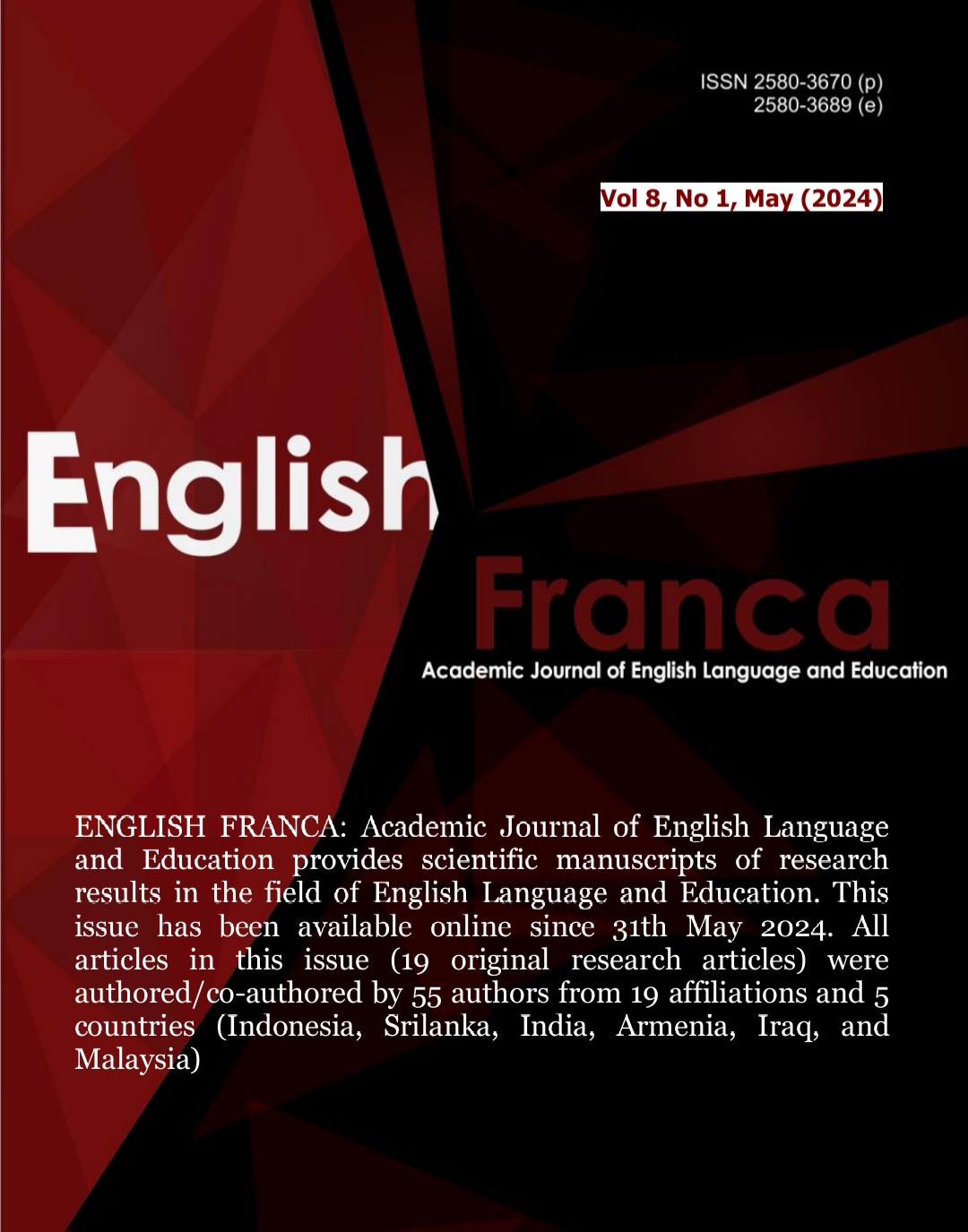Teachers Strategy in doing Listening Skill of CEFR B1 and B2 Level Test based on Self-Reflection
DOI:
https://doi.org/10.29240/ef.v8i1%20May.9886Abstract
Listening is a receptive skill that plays a crucial role in learning English because it is a language modality used in direct conversation. This study utilized a narrative inquiry approach, a qualitative research method that gathers data through documentation, reflective notes, and participant interviews. Six students from MPBI Class C participated, providing self-reflections on their experiences with listening tasks and strategies. Data collection included detailed self-reflections, semi-structured interviews, and teacher reflective notes, ensuring a comprehensive understanding of the strategies' impact. The primary instrument used in this study was: Self-reflection, Students maintained journals documenting their thoughts, feelings, and observations regarding the listening strategies used in their classes. Interviews with students provided deeper insights into their reflections and allowed for clarification and elaboration on their written reflections. Thematic analysis was employed to analyze the data from self-reflections, interviews, and teacher notes. Key themes related to listening strategies, student experiences, and instructional practices were identified and categorized. Narrative construction techniques were used to create detailed accounts of each participant's experiences, which were then compared and contrasted to identify common patterns and differences. In conclusion, the teacher's strategies significantly benefited students' listening skills development at the CEFR B1 and B2 levels. This study highlights the importance of reflective practices, tailored instruction, and continuous feedback in enhancing language proficiency. explore whether there was a difference in this self-reflection of six levels of learning strategies between the different levels of their English proficiency.
Downloads
References
Alexander, O. (n.d.). Exploring teacher beliefs about teaching English for Academic Purposes at low proficiency levels .
Berwald, J.-P., & Chastain, K. (1977). Developing Second Language Skills: Theory to Practice. In The Modern Language Journal (Vol. 61, Issue 4). https://doi.org/10.2307/324832
Gilakjani, A. P. (2012). The significance of pronunciation in English language teaching. English Language Teaching, 5(4), 96–107. https://doi.org/10.5539/elt.v5n4p96
Rao, Z. (2016). Language learning strategies and English proficiency: interpretations from information-processing theory. Language Learning Journal, 44(1), 90–106. https://doi.org/10.1080/09571736.2012.733886
Service, E. T. (2009). Guidelines for the Assessment of English Language Learners. Princeton NJ Educational, 1–42. http://scholar.google.com/scholar?hl=en&btnG=Search&q=intitle:Guidelines+for+the+Assessment+of+English+Language+Learners#1
Brown, H. D. (2007). PRINCPLE of LANGUAGE LEARNING AND TEACHING. In Encyclopedia of the Sciences of Learning (pp. 1743–1745).
Ford, E. (2020). Tell me your story: Narrative inquiry in LIS research. College and Research Libraries, 81(2), 235–247. https://doi.org/10.5860/crl.81.2.235
Gilakjani, A. P. (2012). The significance of pronunciation in English language teaching. English Language Teaching, 5(4), 96–107. https://doi.org/10.5539/elt.v5n4p96
Gulam, K. (1966). Business Communication: Basic Concepts and skills. Intervention in School and Clinic, 2(2), 127–128.
Iskandar, I., Efendi, A. L. I. S., & Santosa, I. (2021). THE MODEL OF LISTENING CEFR-BASED TEST SPECIFICATION FOR HIGHER EDUCATION. 2069(7), 95–106. https://doi.org/10.29300/ling.v7i2.5661
Rost, M. (2013). Teaching and researching listening, second edition. Teaching and Researching Listening, Second Edition, 1–407. https://doi.org/10.4324/9781315833705
Downloads
Published
How to Cite
Citation Check
License
Copyright (c) 2024 Ilma Nurlatifah

This work is licensed under a Creative Commons Attribution-NonCommercial-ShareAlike 4.0 International License.
Authors who publish with this journal agree to the following terms:
- Authors retain copyright and grant the journal right of first publication with the work simultaneously licensed under a Creative Commons Attribution License (CC BY-NC-SA 4.0) that allows others to share the work with an acknowledgment of the work's authorship and initial publication in this journal.
- Authors are able to enter into separate, additional contractual arrangements for the non-exclusive distribution of the journal's published version of the work (e.g., post it to an institutional repository or publish it in a book), with an acknowledgment of its initial publication in this journal.
- Authors are permitted and encouraged to post their work online (e.g., in institutional repositories or on their website) prior to and during the submission process, as it can lead to productive exchanges, as well as earlier and greater citation of published work (See The Effect of Open Access).









